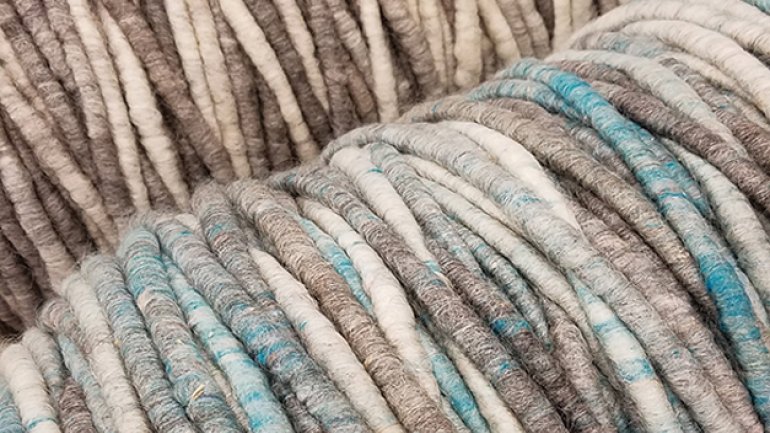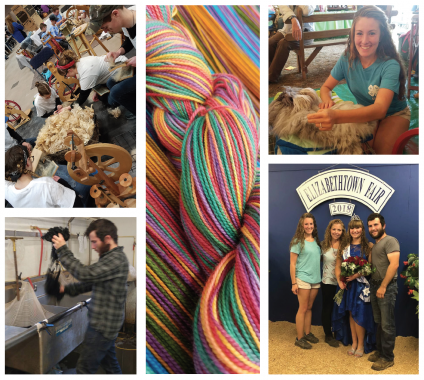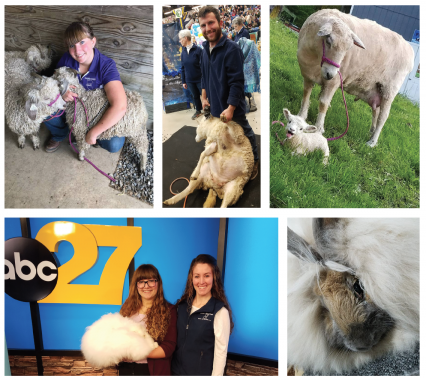Good Shepherds
Good Shepherds
Makers often obsess over the quality of their materials, but how many know much about their origins? Knitters might assume that a skein of wool started as a sheep’s coat, but could they say whether that sheep is a Dorper or a Merino and whether it’s called Bo Peep or Billy the Kid?
Small mills such as the Blue Mountain Farm and Fiber Mill in Harrisburg, Pennsylvania, are helping artisans make more personal connections with their materials. By providing small-batch processing services, they help people turn the fleece of animals they care about – a sheep, goat, alpaca, or bunny – into one-of-a-kind heirloom art materials.
Since 2014, Angie Shaw, 52, and her three adult children have worked at the mill, where they process raw fiber that clients send them. On their 250-acre farm, they also raise award-winning Angora rabbits and Angora goats. Two mini-horses, two Jersey cows, and their dog, Humphrey, round out their menagerie.
Each of the Shaws has a specialty. Ashley, 27, has a degree in agribusiness and is in charge of the mill; she and Angie handle the bulk of the mill’s fiber processing. Tyler, 24, is the family’s shear pro, when he’s not running his own hay-crop business or producing maple syrup. And Madi, 18, who graduates from high school this spring, is the family’s goat expert: She takes care of their flock of 14, makes cheese with their milk, shears them, and spins and weaves their wool.
Living amid serene pastures and caring for fluffy rabbits and frolicsome goats sounds idyllic. But considering the physically taxing, 365-day-a-year workload (Angie also works full-time in finance), it’s no surprise that only 2 percent of Americans live on working farms or ranches.
Angie and Ashley found a moment to talk about how Angora rabbits became their gateway animal, why shearing helps fiber-producing animals stay healthy (even if they don’t always appreciate the process), and their love for 4-H.
You two have been interested in fiber production since Ashley was in elementary school. How did that start?
Angie: The Pennsylvania Farm Show that happens every year in January. It’s a huge event, and it takes place over nine days. There are educational exhibits and competitions. It was an awesome opportunity and a great resource and a place to take my kids. We went every day.
So it really resonated with you.
Ashley: When we were little, we tried all the sports you can think of. We did dance, karate, soccer, basketball, but nothing really clicked. After attending the farm show, we joined 4-H, and it just felt natural.
When did you begin raising animals for fiber?
Ashley: We started growing a hobby farm from our animals that we were raising for 4-H. The Angora rabbits are what we started with, and I’ve had them for years. I tell people they’re like potato chips, because you can’t have just one.
I also had an interest in the Leicester Longwool sheep, and I ended up getting my first one from the youth conservancy program at the Maryland Sheep and Wool Festival. You have to write an essay about your interest in the sheep and why you would like to raise them, and donors choose a youth to donate a ewe to. That’s how we ended up with our first sheep, and then we’ve accumulated or bred them from there. This past year, though, we sold our flock.
My sister had an interest in the Angora goats, so we’ve been raising those for years now, too. She’s been working with different breeders to help increase her herd, as well as the fiber production on her animals.
What advice do you have for people who want to process fiber from their own animals?
Ashley: The main thing is we can only do so much with what we are given, because the end product starts on the animal. So if the animal wasn’t kept clean, or if the fleece wasn’t skirted [debris and low-quality wool removed] or shorn properly, it affects what we can produce from it. The cleaner it comes in to us, the nicer your end product is going to be.
Also, you might bring Sally Lou the alpaca’s fleece to us one year, and we can do one thing with it, but then the next year we’ll have different environmental factors [such as temperature, humidity, and sun exposure], and you can get a totally different fleece from her. So every fleece, no matter if it’s from the same animal, is different.
How many people work at the mill?
Angie: Ashley and I are pretty much full-time.
Ashley: We are time-and-a-half. [Laughs.]
Angie: There are some days that I’ll start at 3:30, 4 o’clock in the morning, just to get a jump on things, and there are days I come home [from my day job] and Ashley’s still out there. So it depends. It is somewhat seasonal. We get more work come shearing time [in the spring].
Ashley: We also have part-time employees like my brother, my sister, and friends.
Who does most of your shearing?
Ashley: Tyler does, and he does shearing for other people, too. We all went to this shearing school in Washington County when we were in 4-H. I was probably 17. All us kids did it, but he definitely was the best. So we were like, all right, we’ll just let you take over the shearing gig. It’s not easy.
What’s so hard about it?
Ashley: It’s very physically intensive. Since attending sheep-shearing school, I’ve gained a much greater appreciation for Tyler and other professional sheep shearers, who make the job look easy. You need to be strong, flexible, and fit in order to maneuver an animal naturally and keep them comfortable while shearing them. With sheep, you sit them up on their butts in order to shear their bellies. They’re not thrilled about it, but the coat has to come off. And you’re trying to do it in a humane way.
Does shearing also help the animal, or is it simply done to harvest fiber?
Ashley: If you didn’t take it off, especially with the rabbits, eventually it’s going to kill them. The rabbits like to clean themselves, but they can’t regurgitate like a cat can. So they’ll just ingest their fiber and then they can’t cough it up. Eventually, they’ll get what’s called wool block, and they can die from it. Whether it’s a sheep or a goat or a rabbit, it’s better for them and their overall health for the fiber to come off.
Angie: All our animals are well cared-for, and if we weren’t shearing them, caring for them, having vet checks, and providing a safe place for them, they wouldn’t be able to live.
How do you help teach other people about treating animals humanely?
Ashley: My sister and my mom organized Angorapalooza, which is the same idea as the sheep to shawl [competitions where teams race to shear a sheep, spin the fleece, and weave it into a shawl], but it’s from rabbit to scarf. This is its fourth year at the Pennsylvania Farm Show. There was a whole uproar about inhumanely harvesting fiber from the Angora rabbits, and major commercial companies stopped selling anything that contained angora. So that was one of the ways that we tried to promote harvesting it humanely – that it has to be done for the health of the animal – and what you can do with it once it’s been harvested.
It sounds like a ton of fun, but also a lot of work.
Angie: My son loves the saying, “Love what you do, and you’ll never have to work a day in your life.”




